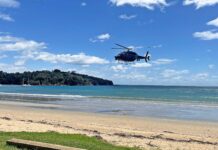On Sunday, 1 July 1928, my 14-year-old grandmother Bernie saw something she would remember for the rest of her life. Her mother had taken her to see the unveiling of an obelisk at Muritai School in Eastbourne. There was a big crowd and bunting, and a man with a handlebar moustache made a speech. Bernie was bored. But then she saw something which astonished her.
The adults around her began to cry.
All her life, she had been told to rein it in. No matter how bad she felt, she was never supposed to cry. Crying was for babies.
“I couldn’t believe it,” she told me, reliving the scene many years later. “All these grown-ups, crying! I asked my mother why they were crying. And she was crying too!”
The obelisk listed the names of local men and boys who had died in World War I, set outside the gates of the school most of them would have attended. New Zealand’s small town war memorials were paid for by local communities without government help. After 10 years of fundraising, the grief of the crowd was still so palpable that the sight and sound never left my grandmother. The Eastbourne memorial needed a large tablet to accommodate so many dead: 168, from a community of around 950.
World War I is still lobbing bombs at us, in some cases literally: Belgian and French farmers still dig up what they call an iron harvest (récolte de fer) – rusty, unexploded ordnance, barbed wire, shrapnel and bullets. World War I collapsed four empires and, as a parting gift, spread a flu pandemic which killed at least 50 million people. Every whānau, it seems, has its own stories.
Two branches of my family come from Kohuratahi, a once-thriving settlement near Whangamomona in Taranaki. In 1918, there was a cheese factory, a post office, a school, a railway station, a store and hall. I grew up hearing about dances and minor scandals – like the girl cousin who arrived from Auckland wearing trousers.
Today, all that remains of Kohuratahi is the hall and a sinister needle – a cenotaph – tall enough to cast a long shadow across the road. On it you can read the names of 41 men, killed in the ‘Great War’. This from a community of 255.
Family who once lived there said the war killed so many boys that it destroyed the town, psychically and economically. Why hold dances, if there are no men? Why have a train station, if no one ever gets off the train? Why have a school, if there are no children?
The Great Depression was the coup de grâce. In the words of my great aunt Joan – daughter of the man who ran the cheese factory – “people worked so hard and got nothing. Money just… disappeared.”
Kohuratahi’s young farmers died in places with names which hold their sense of dread — Arras, Messines, Passchendaele, the Somme, Gallipoli.
When I compare the dates of their deaths, I see that many died in clusters, dates aligned with ‘pushes’ at Gallipoli and the Western Front.
Four died at Gallipoli – three in the month of August 1915, during hopeless, hellish battles for Chunuk Bair and Hill 60.
On Saturday, 15 September 1916, Kohuratahi lost a 22-year-old and two 19-year-olds at the Battle of the Somme, a meatgrinder which consumed 1.2 million dead or wounded.
The next cluster of deaths came on 7 June 1917, when four men died. Another died a day later. Another on 15 June. Another on 20 June.
These dates coincide with the Battle of Messines, which lasted from 7 to 14 June 1917. Many New Zealand historians hail the success at Messines as a major turning point for the Allies in World War I, and a proud moment for New Zealand troops, although it was soon overshadowed by the pointless bloodbath of Passchendaele. Official records report 700 New Zealanders killed and 3000 wounded at Messines, but this, say historians, is probably an understatement.
My wider family was not spared, although my relative wasn’t killed in battle or by disease, but in a senseless accident, the kind which wars seem to produce.
He was a 21-year-old with the unlikely name of Chudleigh Kirton, and he was travelling by train to a New Zealand Expeditionary Force (NZEF) base in England. Chudleigh and his mates, unused to English trains, jumped out on the wrong side after their train stopped. Ten were mowed down by an oncoming train. With staggering insensitivity, the NZEF posted Chudleigh’s bloody clothing back to his parents and billed them for the postage.
Tomorrow is Anzac Day. It honours returned and serving servicemen and women, and New Zealanders killed in all overseas wars, not just World War I. I’ll be thinking of them, although their numbers are, I admit, too vast to comprehend. I’ll also be thinking of those who bravely objected to war. Some belonged to Waikato-Tainui or Taranaki iwi, who didn’t see why they should kill and die for the imperium which stole their land.
For my part, I’ll be mourning the young ghosts of Kohuratahi and a dance hall with cracked windows, sitting silently in a Taranaki paddock.
• Jenny Nicholls
© Waiheke Gulf News Ltd 2025






